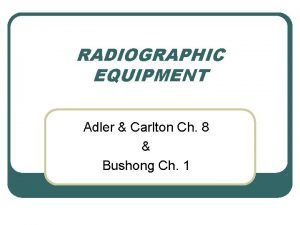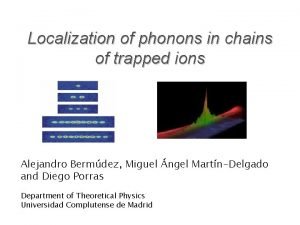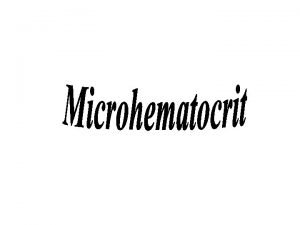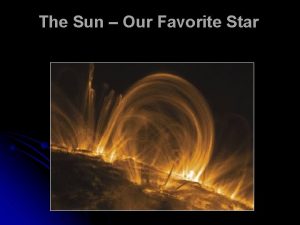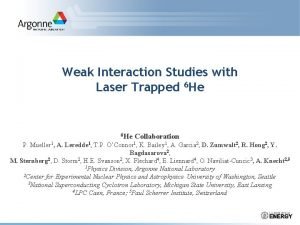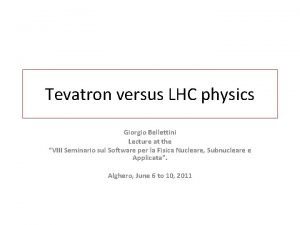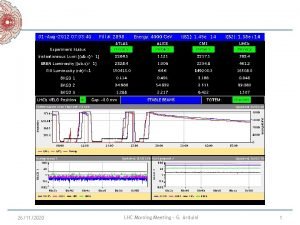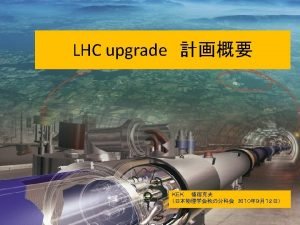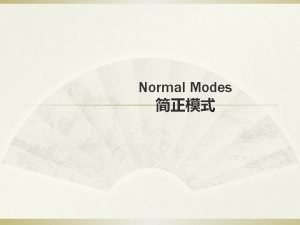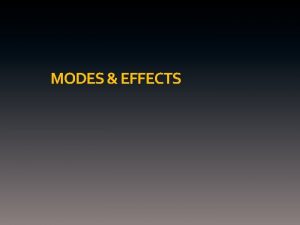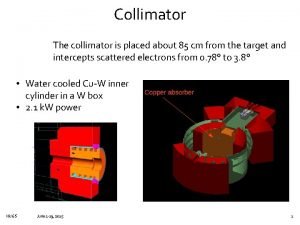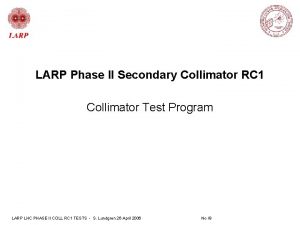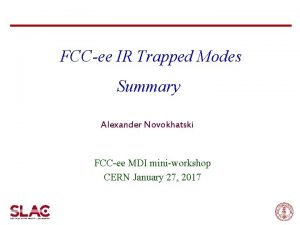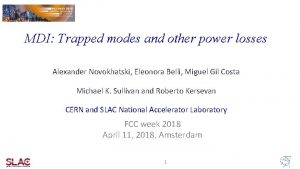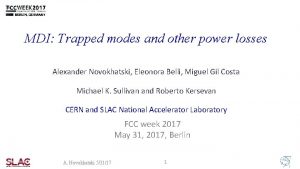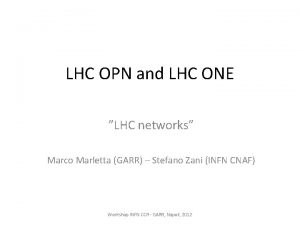Simulation of trapped modes in LHC collimator A














![Table of transverse mode parameters: gap = 5 mm • f[GHz] • 0. 605 Table of transverse mode parameters: gap = 5 mm • f[GHz] • 0. 605](https://slidetodoc.com/presentation_image_h/0fbbce3a536e0c4b6a3784eaf4d89cda/image-15.jpg)


- Slides: 17

Simulation of trapped modes in LHC collimator A. Grudiev

LHC collimator prototype geometry in HFSS

Effective longitudinal impedance calculated using Gdfid. L (left) and measured with SPS beam (right) Measured by F. Caspers and T. Kroyer Second mode First mode Gap varied from 6 to 60 mm

Effective longitudinal impedance calculated using Gdfid. L (left) and measured with SPS beam (right)

Electric field of the first m=0 mode in log scale (gap=10 mm)

First bunch (blue) and total wake (red) along the train for the first m=0 mode f=0. 6 GHz (15 th-harmonic of bunch frequency) Q=136 r/Q = 0. 1 Ohm (accelerator impedance) k = 0. 13 V/n. C (loss factor) For Max. single bunch energy loss: 0. 7 V/n. C x 16 n. C = 11 V Total energy loss per train (2808 bunches): d. E = 0. 5 m. J Dissipated power: d. E x frev = 6 W

Electric field of the second m=0 mode in log scale (gap=10 mm)

First bunch (blue) and total wake (red) along the train for the second m=0 mode f=1. 24 GHz (31 st-harmonic of bunch frequency) Q=892 r/Q = 2. 67 Ohm (accelerator impedance) k = 5. 2 V/n. C (loss factor) For Max. single bunch energy loss: 4 V/n. C x 16 n. C = 64 V Total energy loss per train: d. E = 2. 8 m. J Dissipated power: d. E x frev = 32 W

Longitudinal impedance calculated using Gdfidl (red) and reconstructed from HFSS (blue)

Effective longitudinal (left) and transverse (right) impedance calculated by Gdfid. L Second mode First mode

Q-factor and transverse impedance of trapped modes Transition modes High frequency Tank modes Low frequency Tank modes Gap modes Transition modes and Gap mode have highest transverse impedance

Electric field distribution of some trapped modes (m=1) Low frequency tank modes f = 0. 605 GHz Q = 139 rt = 6. 7 Ohm/mm f = 0. 769 GHz Q = 612 rt = 0. 06 Ohm/mm Transition modes f = 1. 228 GHz Q = 961 rt = 353 Ohm/mm f = 1. 295 GHz Q = 808 rt = 185 Ohm/mm

Electric field distribution of gap modes (m=1) f = 1. 595 GHz Q = 172 rt = 60 Ohm/mm f = 1. 636 GHz Q = 170 rt = 398 Ohm/mm f = 1. 717 GHz Q = 168 rt = 122 Ohm/mm f = 1. 835 GHz Q = 165 rt = 566 Ohm/mm

Electric field distribution of high frequency tank modes (m=1) f = 1. 565 GHz Q = 1294 rt = 4. 5 m. Ohm/mm f = 1. 696 GHz Q = 945 rt = 55 μOhm/mm f = 1. 659 GHz Q = 925 rt = 4. 2 μOhm/mm f = 1. 785 GHz Q = 1430 rt = 36 μOhm/mm
![Table of transverse mode parameters gap 5 mm fGHz 0 605 Table of transverse mode parameters: gap = 5 mm • f[GHz] • 0. 605](https://slidetodoc.com/presentation_image_h/0fbbce3a536e0c4b6a3784eaf4d89cda/image-15.jpg)
Table of transverse mode parameters: gap = 5 mm • f[GHz] • 0. 605 0. 769 0. 799 0. 848 0. 909 1. 226 1. 228 1. 255 1. 295 1. 306 1. 312 1. 315 1. 565 1. 595 1. 611 1. 636 1. 659 1. 672 1. 673 1. 674 1. 696 1. 717 1. 727 1. 767 1. 772 1. 785 1. 815 1. 835 1. 868 1. 898 1. 906 1. 930 1. 983 1. 995 Q 139 612 639 687 751 934 961 1070 808 570 560 530 1294 172 171 170 925 169 940 1356 945 168 958 981 167 1430 1012 165 1028 1494 164 1067 164 1000 rl/Q[Ohm/mm^2] rl[Ohm/mm^2] kl[V/n. C/mm^2] rt/Q[Ohm/mm] 6. 105 e-004 1. 467 e-006 8. 823 e-007 1. 135 e-005 1. 449 e-005 4. 174 e-003 9. 441 e-003 1. 473 e-005 6. 198 e-003 9. 626 e-005 1. 452 e-005 1. 910 e-005 1. 143 e-007 1. 158 e-002 1. 288 e-005 8. 031 e-002 1. 585 e-010 5. 269 e-002 9. 243 e-008 2. 806 e-007 2. 062 e-009 2. 603 e-002 6. 217 e-010 5. 264 e-011 1. 948 e-001 9. 523 e-010 3. 334 e-008 1. 318 e-001 4. 096 e-007 3. 463 e-008 2. 506 e-003 3. 838 e-007 7. 304 e-002 8. 990 e-006 8. 486 e-002 8. 976 e-004 5. 638 e-004 7. 798 e-003 1. 088 e-002 3. 898 e+000 9. 072 e+000 1. 576 e-002 5. 008 e+000 5. 487 e-002 8. 134 e-003 1. 012 e-002 1. 480 e-004 1. 991 e+000 2. 203 e-003 1. 365 e+001 1. 466 e-007 8. 905 e+000 8. 688 e-005 3. 805 e-004 1. 948 e-006 4. 374 e+000 5. 956 e-007 5. 164 e-008 3. 253 e+001 1. 362 e-006 3. 374 e-005 2. 175 e+001 4. 210 e-004 5. 173 e-005 4. 109 e-001 4. 095 e-004 1. 198 e+001 8. 990 e-003 5. 802 e-004 1. 772 e-006 1. 107 e-006 1. 512 e-005 2. 068 e-005 8. 037 e-003 1. 821 e-002 2. 904 e-005 1. 261 e-002 1. 975 e-004 2. 993 e-005 3. 944 e-005 2. 811 e-007 2. 901 e-002 3. 259 e-005 2. 064 e-001 4. 130 e-010 1. 384 e-001 2. 429 e-007 7. 379 e-007 5. 492 e-009 7. 021 e-002 1. 687 e-009 1. 461 e-010 5. 422 e-001 2. 670 e-009 9. 506 e-008 3. 800 e-001 1. 202 e-006 1. 032 e-007 7. 502 e-003 1. 164 e-006 2. 275 e-001 2. 817 e-005 4. 815 e-002 9. 100 e-005 5. 269 e-005 6. 387 e-004 7. 604 e-004 1. 624 e-001 3. 668 e-001 5. 601 e-004 2. 283 e-001 3. 517 e-003 5. 282 e-004 6. 929 e-004 3. 486 e-006 3. 463 e-001 3. 817 e-004 2. 342 e+000 4. 558 e-009 1. 504 e+000 2. 636 e-006 7. 998 e-006 5. 800 e-008 7. 234 e-001 1. 718 e-008 1. 421 e-009 5. 245 e+000 2. 546 e-008 8. 765 e-007 3. 428 e+000 1. 046 e-005 8. 705 e-007 6. 272 e-002 9. 489 e-006 1. 757 e+000 2. 150 e-004 rt[Ohm/mm] kt[V/n. C/mm] kt(Fy)[V/n. C/mm] 6. 693 e+000 5. 570 e-002 3. 367 e-002 4. 388 e-001 5. 710 e-001 1. 517 e+002 3. 525 e+002 5. 993 e-001 1. 845 e+002 2. 005 e+000 2. 958 e-001 3. 672 e-001 4. 511 e-003 5. 957 e+001 6. 526 e-002 3. 982 e+002 4. 216 e-006 2. 541 e+002 2. 478 e-003 1. 085 e-002 5. 481 e-005 1. 215 e+002 1. 646 e-005 1. 394 e-006 8. 759 e+002 3. 640 e-005 8. 870 e-004 5. 656 e+002 1. 075 e-002 1. 300 e-003 1. 029 e+001 1. 012 e-002 2. 882 e+002 2. 150 e-001 4. 576 e-002 1. 099 e-004 6. 613 e-005 8. 508 e-004 1. 086 e-003 3. 128 e-001 7. 076 e-001 1. 104 e-003 4. 645 e-001 7. 214 e-003 1. 089 e-003 1. 431 e-003 8. 570 e-006 8. 677 e-001 9. 656 e-004 6. 019 e+000 1. 188 e-008 3. 949 e+000 6. 927 e-006 2. 103 e-005 1. 545 e-007 1. 951 e+000 4. 660 e-008 3. 945 e-009 1. 460 e+001 7. 138 e-008 2. 499 e-006 9. 881 e+000 3. 070 e-005 2. 595 e-006 1. 878 e-001 2. 877 e-005 5. 474 e+000 6. 738 e-004 4. 507 e-002 1. 078 e-004 6. 769 e-005 8. 432 e-004 1. 074 e-003 3. 154 e-001 7. 040 e-001 1. 072 e-003 4. 513 e-001 6. 707 e-003 1. 178 e-003 1. 255 e-003 9. 109 e-006 8. 508 e-001 1. 628 e-003 5. 867 e+000 1. 182 e-008 3. 924 e+000 6. 866 e-006 2. 075 e-005 1. 470 e-007 1. 872 e+000 6. 611 e-008 4. 446 e-009 1. 429 e+001 1. 497 e-007 2. 525 e-006 9. 742 e+000 3. 003 e-005 2. 913 e-006 1. 866 e-001 2. 992 e-005 5. 509 e+000 7. 114 e-004

Transverse impedance calculated using Gdfidl (red) and reconstructed from HFSS data (blue)

Estimate of tune shift due to l=0 head-tail mode in SPS
 Collimator types
Collimator types Collimator
Collimator Collimator of x ray tube
Collimator of x ray tube Collimator types
Collimator types Collimator
Collimator 4 types of weather fronts
4 types of weather fronts How does the news of the pearl affect the priest
How does the news of the pearl affect the priest Dominant rules
Dominant rules Trapped
Trapped Trapped plasma
Trapped plasma Prominences are ionized gases trapped by
Prominences are ionized gases trapped by Weak interaction
Weak interaction Emotion code chart
Emotion code chart Significant figures
Significant figures Tevatron vs lhc
Tevatron vs lhc Forum lhc
Forum lhc Hl-lhc schedule
Hl-lhc schedule Lhc morning meeting
Lhc morning meeting


